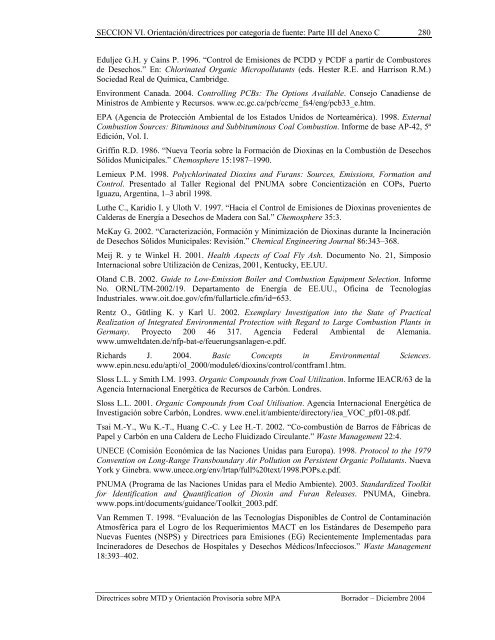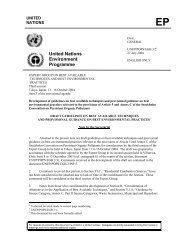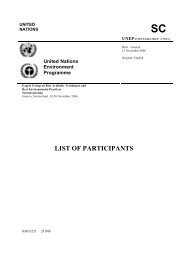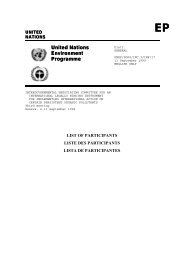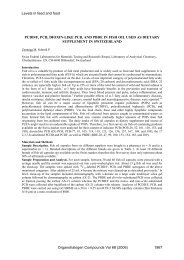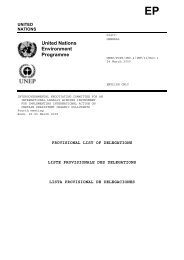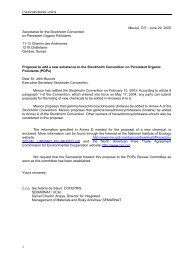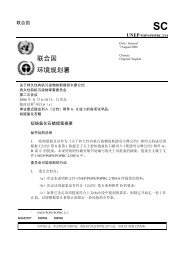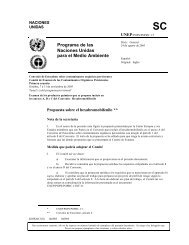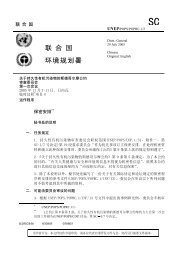Programa de las Naciones Unidas para el Medio Ambiente
Programa de las Naciones Unidas para el Medio Ambiente
Programa de las Naciones Unidas para el Medio Ambiente
You also want an ePaper? Increase the reach of your titles
YUMPU automatically turns print PDFs into web optimized ePapers that Google loves.
SECCION VI. Orientación/directrices por categoría <strong>de</strong> fuente: Parte III <strong>de</strong>l Anexo C 280<br />
Eduljee G.H. y Cains P. 1996. “Control <strong>de</strong> Emisiones <strong>de</strong> PCDD y PCDF a partir <strong>de</strong> Combustores<br />
<strong>de</strong> Desechos.” En: Chlorinated Organic Micropollutants (eds. Hester R.E. and Harrison R.M.)<br />
Sociedad Real <strong>de</strong> Química, Cambridge.<br />
Environment Canada. 2004. Controlling PCBs: The Options Available. Consejo Canadiense <strong>de</strong><br />
Ministros <strong>de</strong> <strong>Ambiente</strong> y Recursos. www.ec.gc.ca/pcb/ccme_fs4/eng/pcb33_e.htm.<br />
EPA (Agencia <strong>de</strong> Protección Ambiental <strong>de</strong> los Estados Unidos <strong>de</strong> Norteamérica). 1998. External<br />
Combustion Sources: Bituminous and Subbituminous Coal Combustion. Informe <strong>de</strong> base AP-42, 5ª<br />
Edición, Vol. I.<br />
Griffin R.D. 1986. “Nueva Teoría sobre la Formación <strong>de</strong> Dioxinas en la Combustión <strong>de</strong> Desechos<br />
Sólidos Municipales.” Chemosphere 15:1987–1990.<br />
Lemieux P.M. 1998. Polychlorinated Dioxins and Furans: Sources, Emissions, Formation and<br />
Control. Presentado al Taller Regional <strong>de</strong>l PNUMA sobre Concientización en COPs, Puerto<br />
Iguazu, Argentina, 1–3 abril 1998.<br />
Luthe C., Karidio I. y Uloth V. 1997. “Hacia <strong>el</strong> Control <strong>de</strong> Emisiones <strong>de</strong> Dioxinas provenientes <strong>de</strong><br />
Cal<strong>de</strong>ras <strong>de</strong> Energía a Desechos <strong>de</strong> Ma<strong>de</strong>ra con Sal.” Chemosphere 35:3.<br />
McKay G. 2002. “Caracterización, Formación y Minimización <strong>de</strong> Dioxinas durante la Incineración<br />
<strong>de</strong> Desechos Sólidos Municipales: Revisión.” Chemical Engineering Journal 86:343–368.<br />
Meij R. y te Wink<strong>el</strong> H. 2001. Health Aspects of Coal Fly Ash. Documento No. 21, Simposio<br />
Internacional sobre Utilización <strong>de</strong> Cenizas, 2001, Kentucky, EE.UU.<br />
Oland C.B. 2002. Gui<strong>de</strong> to Low-Emission Boiler and Combustion Equipment S<strong>el</strong>ection. Informe<br />
No. ORNL/TM-2002/19. Departamento <strong>de</strong> Energía <strong>de</strong> EE.UU., Oficina <strong>de</strong> Tecnologías<br />
Industriales. www.oit.doe.gov/cfm/fullarticle.cfm/id=653.<br />
Rentz O., Gütling K. y Karl U. 2002. Exemplary Investigation into the State of Practical<br />
Realization of Integrated Environmental Protection with Regard to Large Combustion Plants in<br />
Germany. Proyecto 200 46 317. Agencia Fe<strong>de</strong>ral Ambiental <strong>de</strong> Alemania.<br />
www.umw<strong>el</strong>tdaten.<strong>de</strong>/nfp-bat-e/feuerungsanlagen-e.pdf.<br />
Richards J. 2004. Basic Concepts in Environmental Sciences.<br />
www.epin.ncsu.edu/apti/ol_2000/module6/dioxins/control/contfram1.htm.<br />
Sloss L.L. y Smith I.M. 1993. Organic Compounds from Coal Utilization. Informe IEACR/63 <strong>de</strong> la<br />
Agencia Internacional Energética <strong>de</strong> Recursos <strong>de</strong> Carbón. Londres.<br />
Sloss L.L. 2001. Organic Compounds from Coal Utilisation. Agencia Internacional Energética <strong>de</strong><br />
Investigación sobre Carbón, Londres. www.en<strong>el</strong>.it/ambiente/directory/iea_VOC_pf01-08.pdf.<br />
Tsai M.-Y., Wu K.-T., Huang C.-C. y Lee H.-T. 2002. “Co-combustión <strong>de</strong> Barros <strong>de</strong> Fábricas <strong>de</strong><br />
Pap<strong>el</strong> y Carbón en una Cal<strong>de</strong>ra <strong>de</strong> Lecho Fluidizado Circulante.” Waste Management 22:4.<br />
UNECE (Comisión Económica <strong>de</strong> <strong>las</strong> <strong>Naciones</strong> <strong>Unidas</strong> <strong>para</strong> Europa). 1998. Protocol to the 1979<br />
Convention on Long-Range Transboundary Air Pollution on Persistent Organic Pollutants. Nueva<br />
York y Ginebra. www.unece.org/env/lrtap/full%20text/1998.POPs.e.pdf.<br />
PNUMA (<strong>Programa</strong> <strong>de</strong> <strong>las</strong> <strong>Naciones</strong> <strong>Unidas</strong> <strong>para</strong> <strong>el</strong> <strong>Medio</strong> <strong>Ambiente</strong>). 2003. Standardized Toolkit<br />
for I<strong>de</strong>ntification and Quantification of Dioxin and Furan R<strong>el</strong>eases. PNUMA, Ginebra.<br />
www.pops.int/documents/guidance/Toolkit_2003.pdf.<br />
Van Remmen T. 1998. “Evaluación <strong>de</strong> <strong>las</strong> Tecnologías Disponibles <strong>de</strong> Control <strong>de</strong> Contaminación<br />
Atmosférica <strong>para</strong> <strong>el</strong> Logro <strong>de</strong> los Requerimientos MACT en los Estándares <strong>de</strong> Desempeño <strong>para</strong><br />
Nuevas Fuentes (NSPS) y Directrices <strong>para</strong> Emisiones (EG) Recientemente Implementadas <strong>para</strong><br />
Incineradores <strong>de</strong> Desechos <strong>de</strong> Hospitales y Desechos Médicos/Infecciosos.” Waste Management<br />
18:393–402.<br />
Directrices sobre MTD y Orientación Provisoria sobre MPA Borrador – Diciembre 2004


